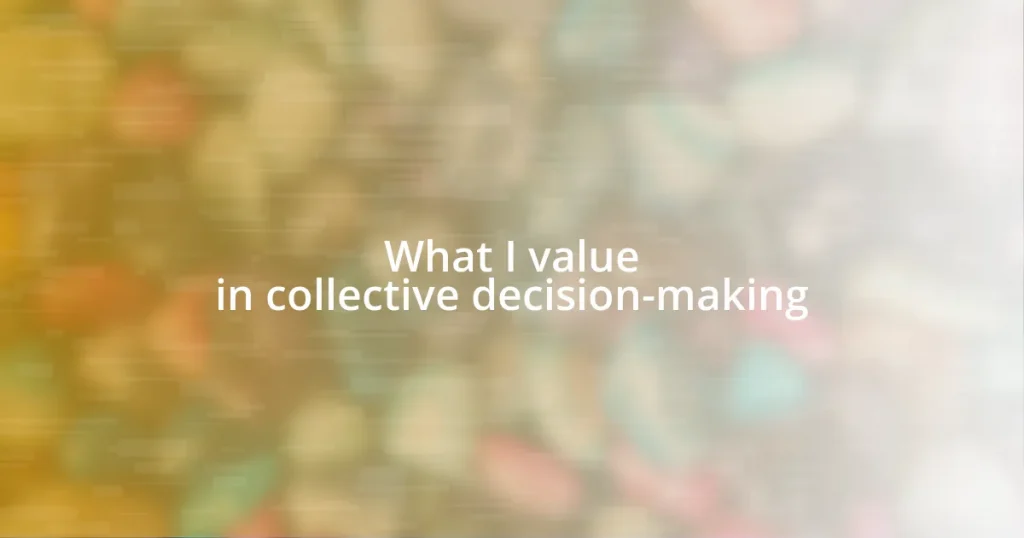Key takeaways:
- Collective decision-making harnesses diverse perspectives, enhancing creativity and fostering a sense of ownership among team members.
- Key principles for inclusive input include actively inviting contributions, creating a safe space for expression, and encouraging continuous feedback.
- Techniques like structured turn-taking, visual aids, and summarization during discussions promote engagement and clarity in group decision-making.
- Evaluating group decisions involves reflecting on both outcomes and team dynamics, emphasizing the importance of open dialogue and emotional insights.
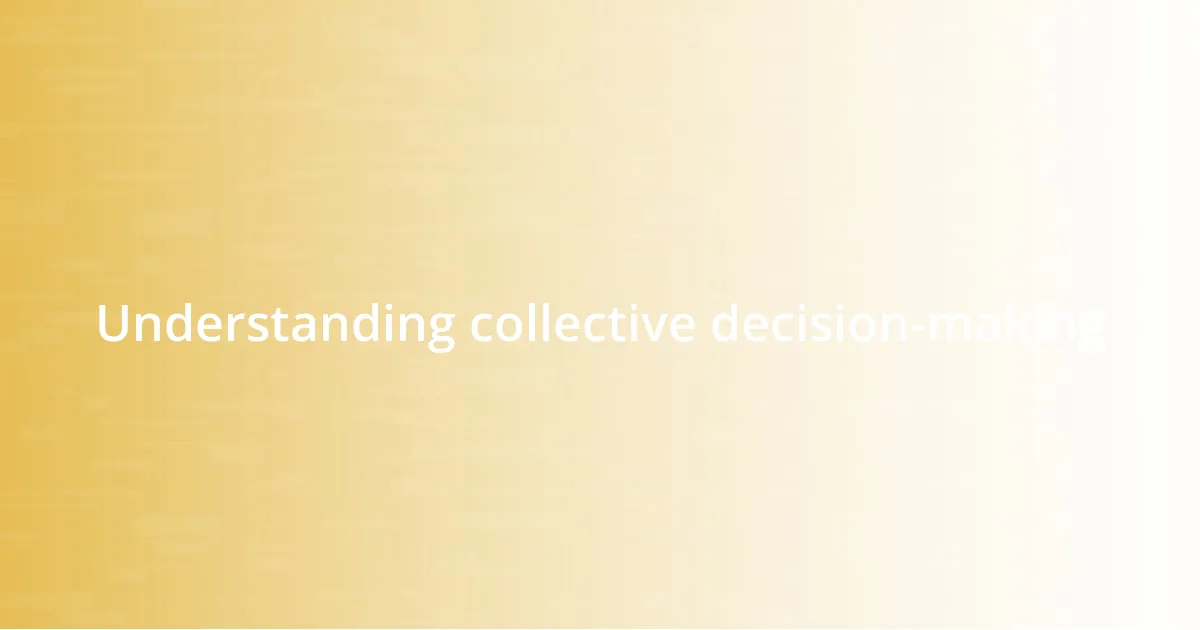
Understanding collective decision-making
Collective decision-making is like a tapestry woven from various perspectives and experiences. I remember a time when my team faced a significant project hurdle. Instead of jumping to conclusions, we held an open discussion where everyone shared their thoughts. That process revealed solutions I hadn’t even considered before, highlighting how diverse viewpoints can spark innovative ideas.
It’s fascinating how the emotions involved in decision-making can either unite or divide a group. I once observed a team brought to an impasse simply because fear of disagreement stifled creativity. In such moments, I often ask myself: how can we cultivate an environment where everyone feels safe and valued? The answer lies in fostering trust, ensuring that all voices resonate within the dialogue.
Moreover, the structure of how we make decisions can deeply influence outcomes. I’ve noticed that when we employ techniques like brainstorming or even anonymous voting, it often leads to a wealth of ideas that might otherwise remain buried. Isn’t it intriguing how simply altering the way we communicate can enhance our collective intelligence? This approach not only democratizes the decision-making process but also enriches the final decision with a depth that transcends individual capabilities.
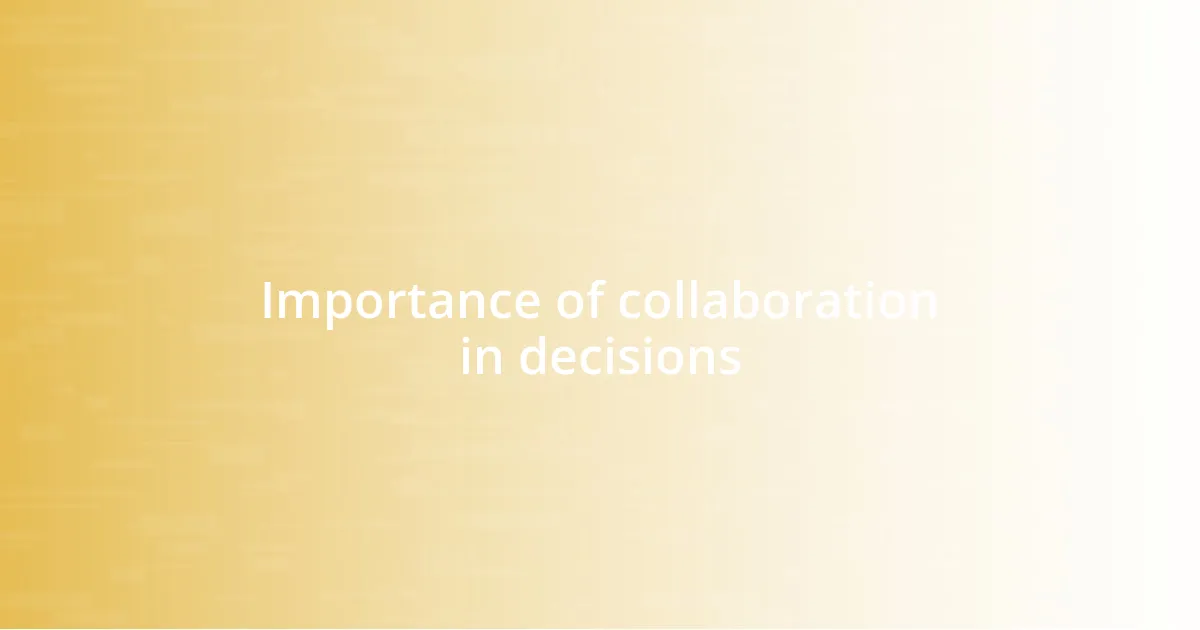
Importance of collaboration in decisions
Collaboration in decision-making is crucial because it pools together different perspectives, leading to more comprehensive solutions. I recall a team brainstorming session where we had to decide on a marketing strategy. Initially, I was convinced my approach was the best, but as my colleagues shared their insights, we discovered a much more effective blend of ideas. That experience taught me that collaboration not only enhances creativity but also fosters a sense of ownership and commitment among team members.
When we work together, we open the door to a multitude of benefits that can drastically impact the quality of our decisions:
- Diverse perspectives: Each team member brings unique experiences and viewpoints.
- Increased buy-in: When everyone has a say, they’re more likely to support the final decision.
- Enhanced creativity: Collective brainstorming often leads to innovation that wouldn’t emerge individually.
- Shared responsibility: Decisions made collaboratively distribute accountability, alleviating pressure on a single individual.
- Stronger relationships: Working together toward a common goal builds trust and camaraderie among team members.
These elements combine to create a richer decision-making environment that simply can’t be matched by individual effort.
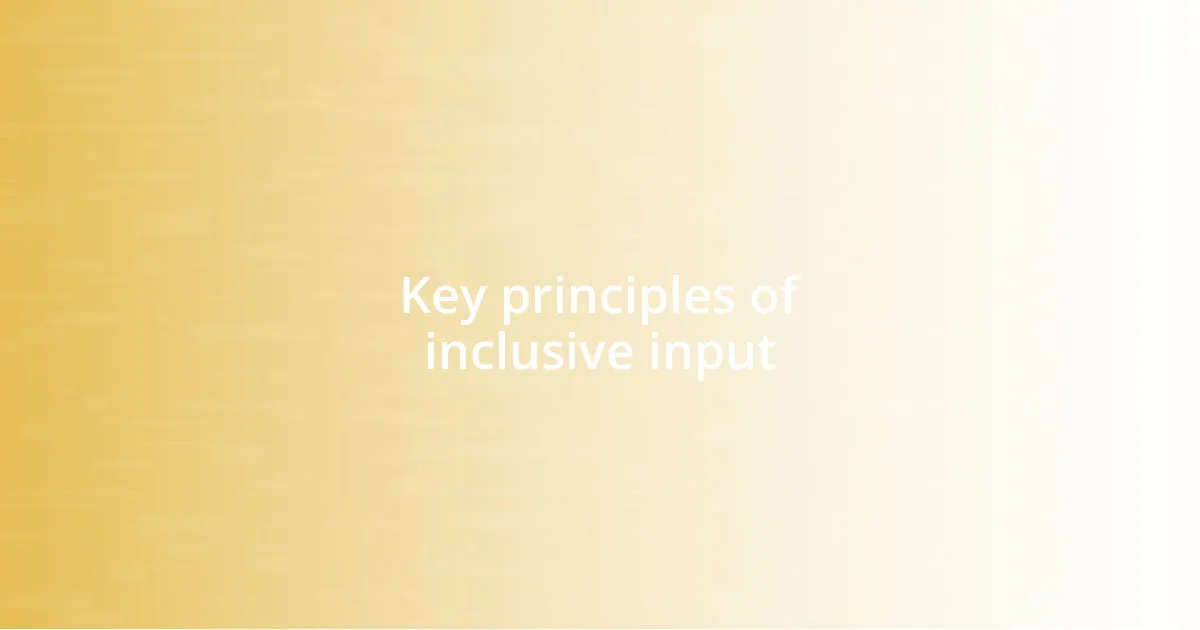
Key principles of inclusive input
Inclusive input thrives on key principles that ensure everyone feels heard and valued. One principle I’ve seen work wonders is actively inviting contributions from all members, regardless of their role. I remember a project where, during our meetings, we made it a point to go around the table, allowing even the quietest team members a moment to share their thoughts. The outcome was incredibly eye-opening. It wasn’t just the louder voices that shaped our direction; hidden gems of wisdom emerged from unexpected places, enriching our discussions in ways I couldn’t have predicted.
Another essential principle is creating a safe space for expression. I’ve experienced moments where the pressure of judgment can stifle creativity. For example, in a previous project, a colleague hesitated to share an innovative idea, fearing it wouldn’t be accepted. Once we reassured everyone that all ideas were valuable, she opened up about a concept that transformed our approach entirely. This incident highlighted how cultivating an environment free from fear not only encourages sharing but also fosters genuine innovation.
Lastly, feedback is vital in the inclusive input process. I often urge my teams to provide constructive feedback throughout our discussion, rather than waiting until the end. During a recent session, we practiced continuous feedback loops, which allowed us to adjust our ideas in real-time. This dynamic exchange kept the energy alive and ensured we were all aligned moving forward. By emphasizing the importance of feedback, we create a collaborative atmosphere where ideas can evolve, ultimately leading to better decision-making.
| Principle | Description |
|---|---|
| Active Invitation | Encouraging contributions from every team member, fostering diverse input. |
| Safe Space | Creating an environment where everyone feels comfortable expressing ideas. |
| Continuous Feedback | Encouraging real-time feedback to refine ideas collaboratively. |
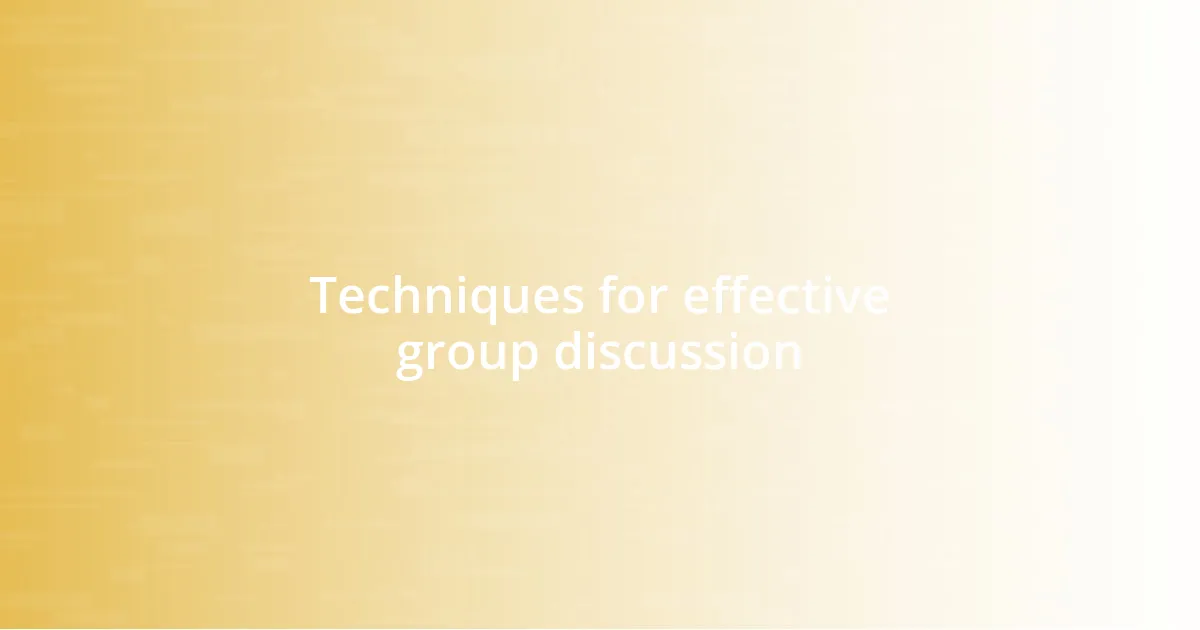
Techniques for effective group discussion
During group discussions, one effective technique I’ve found is to facilitate structured turn-taking. Rather than letting the conversation spiral into overlapping voices, I often suggest a round-robin format. This way, each member has a designated time to share their ideas without interruption. I distinctly remember a time when implementing this structure led us to uncover a variety of unique insights. I felt the energy in the room shift; people were genuinely more engaged and eager to share, knowing their voice would be heard.
Another technique that has proven beneficial is the use of visual aids during discussions. In one of my previous projects, we employed a whiteboard to jot down key points and ideas as they emerged. I noticed how this simple act transformed the dynamic. It allowed team members to build on each other’s thoughts visually, sparking deeper discussions. It also made it easier for us to stay organized and focused, which is crucial for effective outcomes. Isn’t it fascinating how a little bit of visual representation can elevate collaborative thinking?
Finally, I believe in the power of summarization throughout the discussion. Taking a moment here and there to recap what’s been said not only reinforces understanding but also makes people feel valued. I recall a particularly impactful meeting where, after every few points, I’d highlight the main takeaways. This practice led to a clearer direction and encouraged others to chime in with their viewpoints. It made me realize how important it is to ensure everyone is on the same page. Without this technique, it’s easy to get lost in all the ideas being thrown around, wouldn’t you agree?
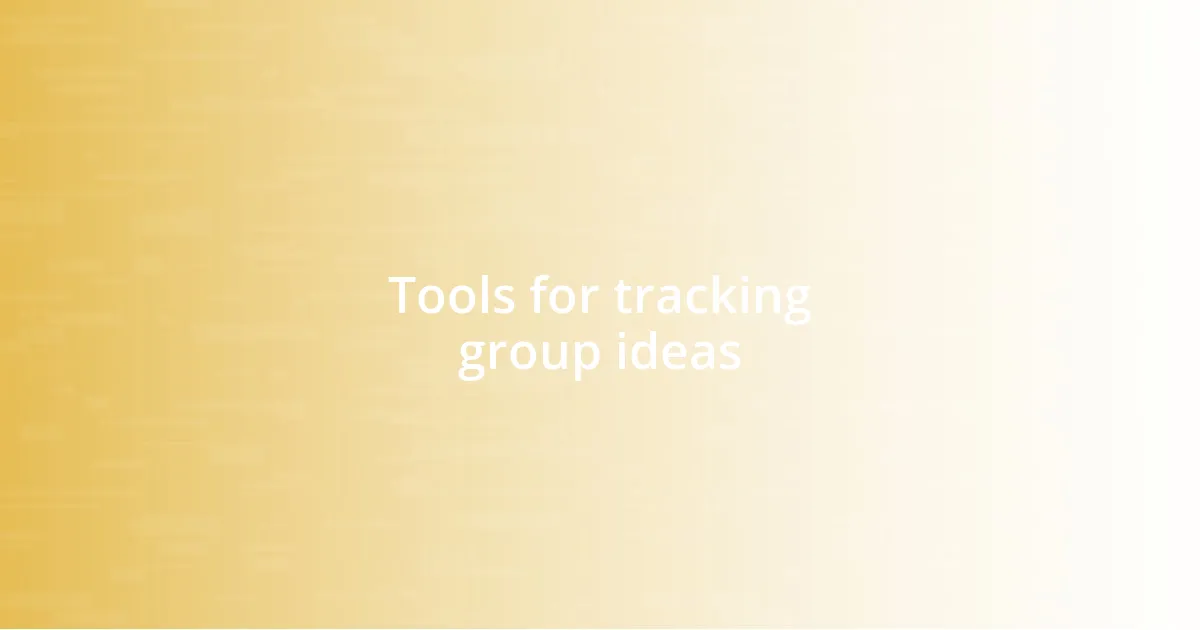
Tools for tracking group ideas
Tracking group ideas effectively is crucial for ensuring everyone stays on the same page. I’ve found digital tools incredibly helpful for this purpose. For example, in one team I worked with, we used a collaborative platform like Miro. We set up a virtual whiteboard where everyone could contribute their thoughts in real time. Watching team members interact with one another’s ideas sparked a sense of creativity that energized our discussions. Isn’t it amazing how a digital space can replicate the buzz of a brainstorming session?
In another instance, we utilized project management software to track our ideas and decisions. Every suggestion made during meetings was logged in a shared document, and this practice fostered a sense of accountability. It surprised me how often we revisited those notes, pulling ideas from earlier conversations that had moments of brilliance but hadn’t been fully explored. This practice not only kept us organized but also reminded us that no idea is ever truly lost—it just needs the right moment to shine.
I also recognize the power of simple methods like sticky notes in both physical and virtual formats. I recall a session where everyone wrote down their ideas on sticky notes and placed them on a wall. This tactile approach created a visual map of our discussions that we could continually return to. It was rewarding to see how an “idea wall” became a canvas for our collective creativity. Isn’t it wonderful how some of the most effective tools can be so straightforward?
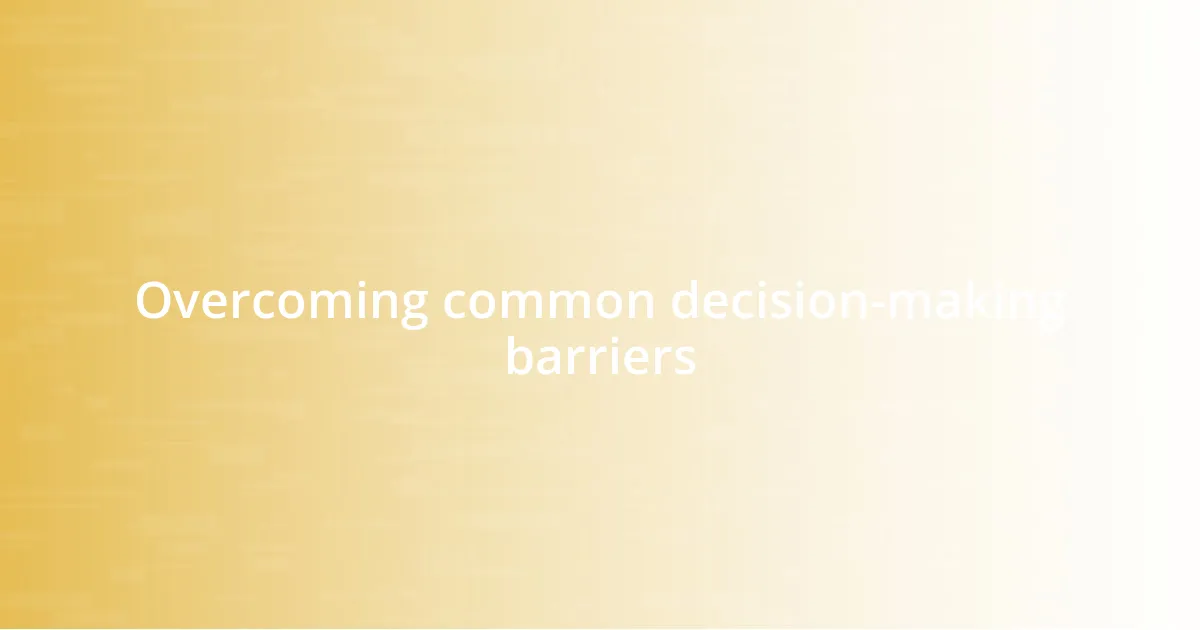
Overcoming common decision-making barriers
One barrier I often encounter in group decision-making is the fear of conflict. When individuals hesitate to voice differing opinions, it can stifle creativity and lead to stale outcomes. I remember a meeting where tension filled the room because no one wanted to challenge the prevailing view. It wasn’t until I encouraged an open forum for dissent that the floodgates opened. Suddenly, a clash of ideas brought fresh perspectives to the table, turning a standoff into a productive dialogue. Have you ever noticed how addressing disagreements can actually strengthen group cohesion?
Another common hurdle is decision paralysis, especially when faced with too many options. I’ve felt that overwhelming sensation myself—like standing in front of a vast buffet and not knowing where to start! In a recent project, my team used a simple prioritization grid to sift through possibilities. By ranking options based on relevance and impact, decision-making became much clearer. This not only streamlined our process but also energized the group, allowing us to move forward confidently. Isn’t it interesting how clarity can transform uncertainty into action?
Lastly, I’ve seen how poor time management can derail the decision-making process. There was an instance when we allocated vague time limits for discussions, leading to endless debates with no conclusion. To remedy this, we implemented strict time slots for each agenda item, and I was pleasantly surprised by how it heightened our focus. Surprisingly, setting a timer turned what could have been chaotic into a dynamic exchange—people shared their insights more succinctly and effectively. Have you ever tried adding time constraints to discussions? It might just be the key to wrangling those wandering conversations back on track.
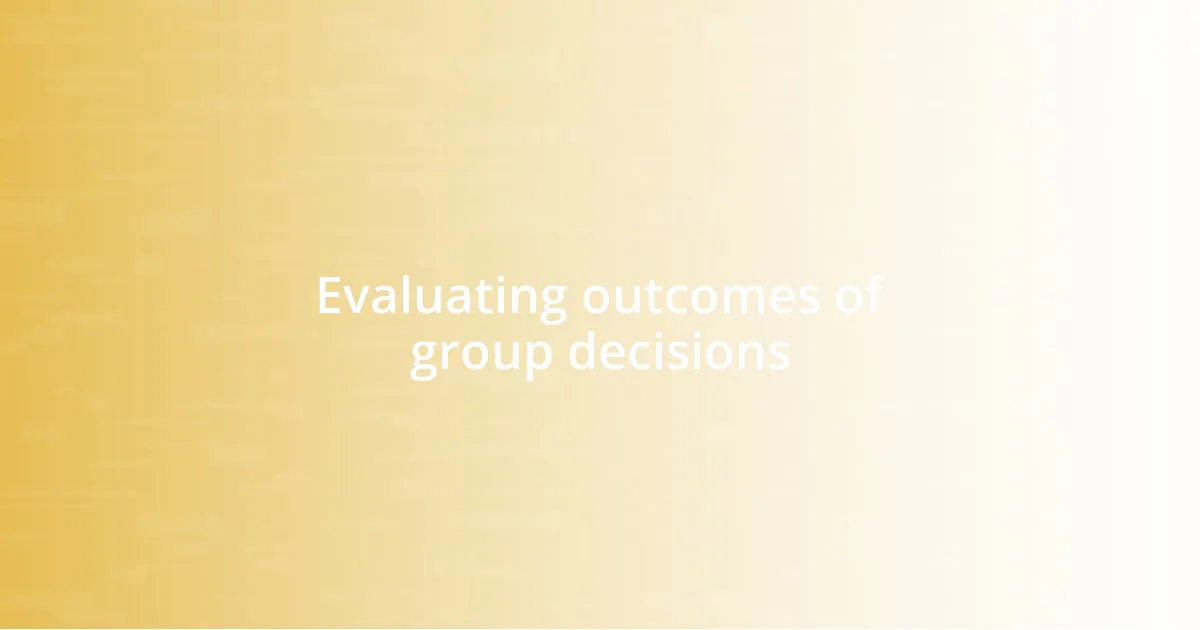
Evaluating outcomes of group decisions
When it comes to evaluating the outcomes of group decisions, I’ve learned that reflection is key. After implementing a decision, I like to gather the team to assess what worked and what didn’t. For instance, during a project launch, we held a debriefing session. It was eye-opening to hear differing perspectives on our chosen approach. Did the outcome align with our initial goals? This simple practice transformed how we viewed success—shifting it from just results to a holistic understanding of the process.
One particular evaluation sticks in my mind. After a marketing campaign, we analyzed both the metrics and the team dynamics. Sure, the numbers showed a slight uptick in engagement, but what really mattered was the feedback from team members about their roles. Some felt more empowered than others—those insights were invaluable. I realized that understanding the emotional impact on teammates could be just as critical as the final figures. How often do we focus solely on the data and forget the human element?
In my experience, a crucial aspect of these evaluations is cultivating a culture of open dialogue. I’ve noticed that teams thrive when feedback is not only welcomed but expected. In one project, we developed a scorecard for our decisions, focusing on criteria like team involvement and overall morale. Surprisingly, this not only provided a clear framework for analysis but also sparked lively conversations about our aims. Have you ever implemented something similar? It can reveal not just the strengths of your decisions but also the areas ripe for growth, guiding future endeavors in a more meaningful way.










